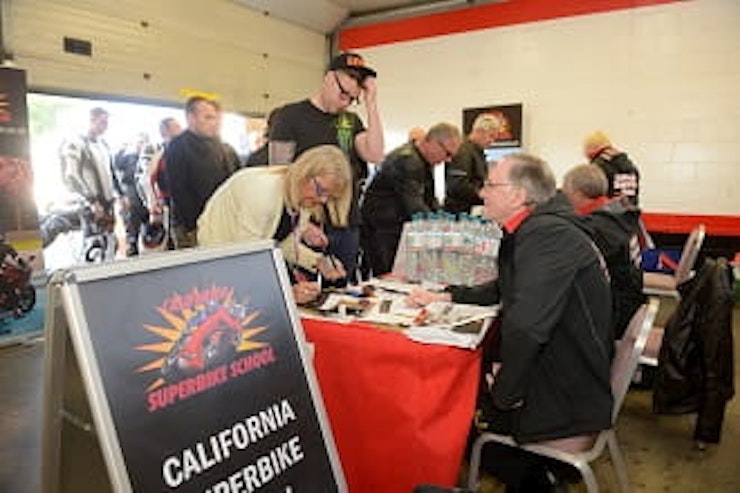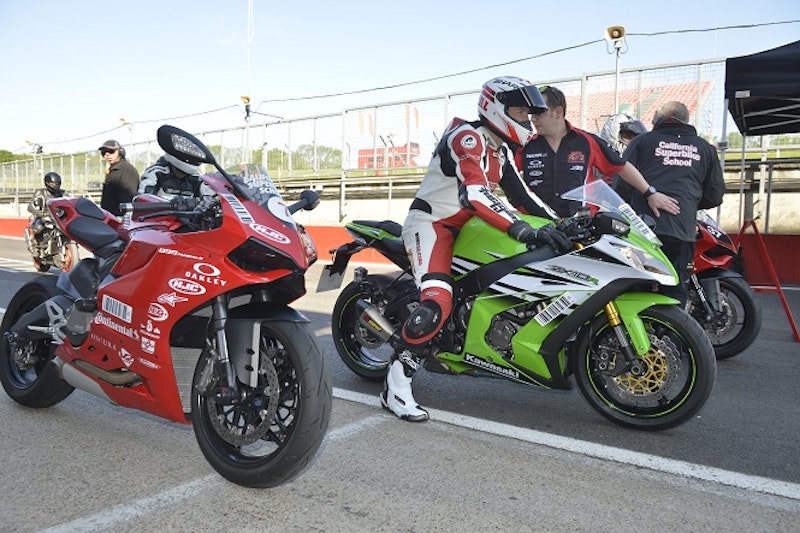Thankfully Level 2 of the California Superbike School’s 4-level development process is here to help. Designed to develop your visual skills to make the road or track an easier place to ride, spotting danger, a reference point or even an exit point of a corner early enough to amend your line.
The techniques of using our eyes more effectively are included in a 5-step process with each classroom lesson followed by the opportunity to put into practice on the track alongside your own instructor. After completing Level 1 in August 2014 at Silverstone, on this occasion it was the Brands Hatch Indy Circuit for my on-loan Kawasaki ZX-10R and I.
Arriving at 7am with licence and riding gear in hand ready for signing-on and the relevant checks, you are quickly laden with plenty of other goodies from sponsors’ leaflets and a bottle of water to numbered stickers for your bike and a notebook. Mechanics are on site to check your tyre pressures and noise test too ahead of a group wide introductory briefing as feelings of excitement and nervousness get all intertwined.
I joined 60 other students some who have been before and progressed though the levels only to revisit earlier levels to fine-tune their techniques. Level 4 riders aren’t necessarily better riders, it just means they’ve been at least three times before because you’re not able to progress to the next level until you’ve completed the previous one.
The 20-strong team of professional riders, tutors and admin staff are super-efficient and run the day like clockwork. Each hour is split into three lots of 20 minutes so you’ll either be riding/debriefing, in the classroom or having 20 minutes to yourself to digest the information and prepare for the next session.
The beauty of a day like this is there’s plenty of time to meet fellow enthusiasts usually with the opening gambit of “which level are you doing?” followed quickly by “cool, and what are you riding?” Each riding coach is assigned 2-3 students and I found this method ideal with enough time at the end of each track session for one-to-one feedback. The coaches communicate via pre-designated hand signals on the circuit to remind you of each drill’s focus.
Like a cake recipe, as the day progresses each drill incorporates more ingredients in the shape of techniques, gears and brakes. Confidence in your own ability grows with every session which results in faster and more efficient riding. The challenge of finding my quickest line around Paddock Hill Bend became a sub-fixation of the day, not only was I learning more in several hours than ever before but I was doing so on one of the UK’s most exhilarating circuits. From braking, entry and apex points to an exit strategy for each corner leading into the next. How early could I feed in the power coming onto the start/finish straight? Where is the apex at Druids? Where is the braking point for Graham Hill Bend? How far around McLaren and Clearways should I be looking? Level 2 keeps on pounding you full of new information and techniques that by the fifth and final on-track session of the day when you are permitted to incorporate more gears and heavier braking your brain struggles to process everything quickly enough. And this is why the coaches tell you to ride at 80% of your capability. You are there to develop your own skills not attempt lap records. Leave that to the British Superbike brigade.
Every time you ride a bike you never stop learning and where better than on a circuit with no other vehicles heading towards you nor any offensive road conditions. The Indy circuit might only be 1.2 miles but there’s never a break, you’re always busy looking for your next reference point and creating a smoother flow of information purposely to tell yourself where you are and what to do. The more information you can soak in the better positioned you are going to be to alienate danger and create a smoother, faster line. And that might be a different line each lap (on track) or each corner (on the road) depending on what’s around you.
During the early MotoGP days of 2003/4, Sete Gibernau used to plough the same line lap after lap fine-tuning his optimum line for the perfect qualifying time. Meanwhile Valentino Rossi would use the practice sessions to explore all sorts of different lines to give himself as much information as possible about the reference points including surface conditions for potential overtaking opportunities during the race. Different lines means it’s a different and brand new corner. A new turn-in point affects your apex and exit speed among other variables.
What else do you learn during Level 2? Without giving too much of the game away and as simple as it sounds, lifting your head and looking as far in front as possible to the vanishing point of the road or track is an important step. It will allow you to get on the throttle earlier and provide a smoother line but be careful because your eyes are always alert to danger so the more information we can provide ourselves, the better placed we will be. You’ll learn to assess yourself; when are you most busy on a bike? How can you help yourself become a better rider?
And then onto the final session where you’ll be riding chairs in the classroom in a bid to copy Dani Pedrosa’s style of picking the bike up early in order to get the throttle on sooner. Move that to the track and incorporate all of the days other lessons and it does get a little complicated, so much so that I would advise against doing back-to-back levels on consecutive days.
Conclusion
There’s a huge amount of new information to process and it is delivered in a clear and concise manner initially with the two-way classroom lessons. So in order to maximise your learnings I’d recommend practicing them after the day. You might want to book a place on a track day for a couple of days after your California Superbike School experience for example.
Sure, you feel a little deflated when in the earlier sessions you’re instructed to use no brakes and just one gear but it helps you focus on each drill. If the track gets a little congested just ride through the pits and give yourself some space!
The day is tiring both mentally and physically. You'll work hard on the track practicing and pushing your newly found skills all while staying alert looking for reference points, trying new lines, attempting the 'three-step', picking the bike up out of the corner or looking for the vanishing point of the track. The course is so rewarding though. Use the debrief session wisely, the coaches are there to help you not criticise and I certainly came away a better rider.
On every ride you are constantly learning yet the CSS will refine what to concentrate on to make you a more efficient rider with the ability to spot danger earlier. The course is an absolute essential and you’ll come away regretting not having done it sooner.
The ZX-10R ran so well throughout and my coach Butch even offered come added pointers with my riding style which was upsetting the bike on corner entry so we smoothed those out with an extra 10-minute lunchtime lesson; all part of the service.
Top Tips
Drink plenty of water; you’ll be given a 2-litre bottle when you sign-on
Check the condition of your tyres and their pressures
Fill up with fuel before you arrive
20 minutes of every hour will be down time, use it wisely
Take a pack-up or plenty of money for the highly priced lunch and snack options
Listen to the instructions and ask as many questions as possible
A professional photographer is on site allowing you purchase pics from the day
The School was founded by motorcycle racer, author and instructor Keith Code in the early 1980’s and now teaches the same techniques in 15 different countries.
Prices for each one-day course start at £415. Three models of Ducati are available to hire with prices from £255 including tyres and fuel. Choose from a Monster 1200S, an 899 Panigale or a 1299 Panigale.
Head to www.Superbikeschool.co.uk for more information. Massive thanks to Badger, Butch, Lynn and team.
Here’s a selection of photos from the day:
Have you had any extra training on-or-off road? Tell us about it.
DON’T LOOK DOWN
We’ve all been there, that moment mid-corner when we’re looking at something else instead of the road ahead – road kill, debris, skid marks leading into a hedge. Something that catches the eye and your brain wants to know more so you keep looking and become so focused on the target that you ride towards it. All of sudden reality bites and you’re hard on the brakes on a rescue mission not to collide with it. Whatever is might be if we’re lucky there’s a little bum clench followed by an exhale and away we go again composure regained and concentration restored.
It’s called Target Fixation and it’s caused because naturally our eyes are always looking for one of three things; Food, Danger or Sex.
Of course only one of those is (usually!) associated with motorcycling but it’s all too easy to focus on the danger and lose your bearings because the awareness of speed and confidence is jeopardised. This is bad news.
VIDEO FROM THE DAY:
Share on social media:

